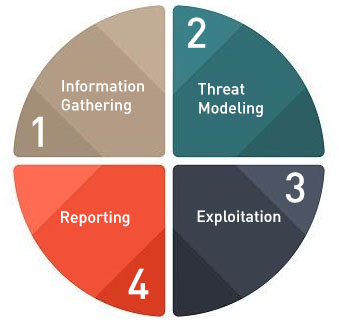What is penetration testing?
Before we get into it, let’s first make sure we’re talking about the same thing. When we talk about penetration testing, we’re referring to viewing your network, application, device, and/or physical security through the eyes of someone with malicious intent. When we conduct a penetration test, we set out to discover an organization’s cybersecurity vulnerabilities. With penetration testing, an encyphr experienced cybersecurity expert can identify:
- Where a hacker might target you
- How they would attack
- How your defenses would fare
- Possible magnitude of the breach.
Penetration testing seeks to identify application layer flaws, network and system-level flaws, and opportunities to compromise physical security barriers too. While automated testing can identify some cybersecurity issues, true penetration testing considers the business’s vulnerability to manual attack as well. Our penetration testing plans utilize approximately 65% automated routines and 35% enhanced manual techniques.

Security testing, also known as penetration testing, sees a team of information security professionals taking an ethical hacking approach to assessing an organization’s security risks. The tester will identify and seek to penetrate vulnerabilities to help a business strengthen its security posture and develop resilience against evolving threats—exactly what a hacker does, but for good and not evil! These simulations of real-world attacks not only highlight hacking opportunities but also lead to concrete solutions on how to better prevent and protect from attacks in the future.
How your organization can benefit from Pentesting
Intelligently manage risks
Pentesting provided detailed information on actual, exploitable security risks. When we perform a penetration-test, we can proactively identify which vulnerabilities are more critical, which are less significant, and which are false positives. This allows your organization to intelligently prioritize remediation efforts, apply needed patches and effectively allocate appropriate resources to ensure that they are available when and where they are needed most.
Reduce the cost of a compromised network
Recovering from a security breach can be costly. A compromised network has the potential of costing an organization millions of dollars related to IT remediation efforts, customer protection and retention programs, legal activities and more.
Meet regulatory compliance and avoid penalties
Penetration testing helps organizations address auditing/compliance and regulation obligations. Our detailed pentesting reports aid organizations to avoid significant fines for non-compliance. They provide the evidence of ongoing due diligence to assessors by maintaining the required security controls.
Retain corporate image and loyalty
A single incident of compromised customer data can be costly in terms of negatively affecting sales and tarnishing an organization’s front-facing image. Customer retention costs are higher than ever, and organizations cannot afford to lose the loyal customers that they’ve worked hard to earn. Publicly acknowledged breaches are likely to turn off new clients. Penetration testing helps you avoid incidents that put your organization’s reputation and trustworthiness on the line.

FREE Pentesting Services Overview
A more in-depth and technical document detailing our scope and includes a sample report and necessary forms.
Penetration Testing Stages
The chart below represents four areas of our basic Pentesting Service. These areas are adjusted based on any additional services.

Information Gathering
Where it all begins. We start the process by performing reconnaissance on our target where we gather as much information as possible to help us understand what we’re up against. This may include active information gathering (where our tester has direct contact with the target) or passive information gathering (where our tester collects information undetected by the target).
Threat Modeling
We identify and categorize assets, threats, and threat communities and weigh their relevance to the organization being tested. What are the primary and secondary assets? What, or who, are the most prominent threats or threat communities? How do these threat communities map to the various assets?
Exploitation
This is where the magic happens, and we earn our reputation. During the exploitation phase, we use the groundwork we’ve set forth from the other phases to successfully abuse, misuse and exploit vulnerable systems, networks, devices, physical controls and/or humans.
Reporting
This where we convey what we’ve learned in a clear, readable, and concise manner. We thoroughly outline and present our findings with suggestions for prioritizing fixes.

